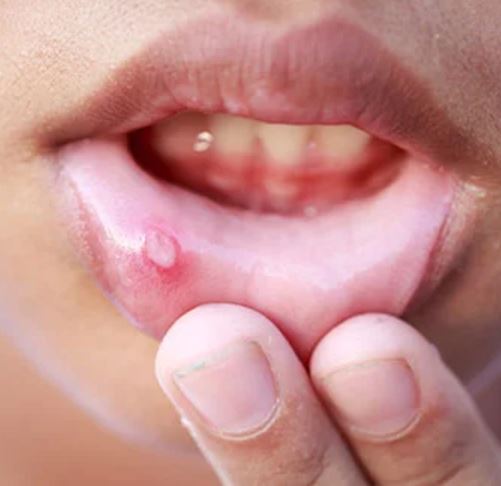Interestingly we are exploring another aspect of oral health. I am excited as I am about to talk to you guys about Canker Sores and as usual I’ll be giving four fantastic tips on how you can feel at ease if you have it later in future. About a third of people who get them have a family history with them, so it’s possible they’re genetic, but stress tends to make them pop up more.
Some may have had it more than twice but do not know the name. You know we are so blessed in this part of the world such that when we don’t know the English name of something, we would just find something closely related to it. So is the case of his CS.
Some who have had it in the past even call it blister. Some who are somewhat well informed refer to it as cold blister while only those who had checked with their doctors would know the real name is Canker sores and not cold sores. Having it is no fun at all. It’s a very uncomfortable experience. You don’t want to eat acidic fruits such as oranges, pineapples, apples…they can hurt pretty badly.
Reason being that there are lots of nerves in the lining of the mouth, which get exposed to saliva, food, drinks, and air when the tissue is broken such that a simple sip of water can aggravate the nerves and cause you a major ouch. I know you guys are curious already. Aren’t you…Canker sores or Cancer sores?
Canker sores or aphthous ulcers are small, shallow ulcers that appear in the mouth and often make eating and talking uncomfortable. These painful but non-contagious sores typically appear on the inner surface of the cheeks and lips, upper surface of the mouth, on the tongue and at the base of the gums. Canker sores can pop up on the insides of your cheek or on your tongue, gums, or soft palate making eating, drinking, and doing pretty much anything with your mouth hurt.
The exact cause is unknown. In severe canker sore attacks, you may fever, physical sluggishness, swollen lymph nodes. They are of two types actually: Simple and complex canker sores.
Simple CS usually appears in children between the ages of 10 and 20 like three or four times a year and last up to a week. Complex canker sores are less common. They occur more often in people who have previously had them. Simple sc is thought to be caused by stress or tissue injury. Some studies claim a sharp tooth surface such as braces or ill-fitting dentures might also trigger it. Complex cs is believed to occur as a result of impaired immune system; nutritional problems, such as vitamin B-12, zinc, folic acid, or iron deficiency; or gastrointestinal tract disease. They are caused by a deficiency of the amino acid lysine which could help clear up canker sores and prevent it according to some authorities.
Canker sores strictly occur inside the mouth. There is usually a tingling/burning sensation before the sores appears. It’s a painful sore inside your mouth: on the tongue, on the soft palate (the back portion of the roof of your mouth), or inside your cheeks. They are usually round, white or gray, with a red edge or border. It is different from cold sores.
Cold sores/ fever blisters/ herpes simplex type 1 are groups of painful, fluid-filled blisters caused by a virus and are extremely contagious. They typically appear outside the mouth — usually under the nose, around the lips, or under the chin. Cold sores can show up anywhere on your body. You could have it when you come into contact with people or things that carry the virus while canker sores are not. Canker sores usually go away on their own in a few days’ time,
4 Home Remedies:
1 Raw Honey: Honey is a natural soother for almost any ailment. It has both antibacterial and antiseptic properties. For canker sores, put a teaspoon of honey around the canker sore. It may hurt for a minute, but soon it will ease both the pain and the inflammation.
This remedy is simple while it does works for getting rid of canker sore. Simply dab some raw honey on the affected area, repeat some times in a day to improve the symptoms. Honey has great anti-inflammatory and anti-bacterial properties, it’s one of the most natural and effective ingredients for relieving pains, including canker sor
2 Coconut oil
Prepare a clean cotton swab, warm up the coconut oil and cool it down. Apply it to the sore using the cotton swab, you’ll get relief instantly. Coconut oil is safe for both adults and kids when it comes to cure canker sores; it works effectively due to its anti-inflammatory and antimicrobial properties.
3 Hydrogen Peroxide: Mix a small amount of hydrogen peroxide solution with an equal amount of water and apply it directly to your canker sore. Rinse your mouth and spit. Repeat this twice a day until the canker sore heals. Typically, this should speed the healing and your sore will disappear in two to three days. Make sure not to swallow the peroxide.
4 Alum Powder: Alum powder is one of the best methods of getting rid of canker sores. Typically found in kitchens, alum can be placed directly on the ulcer. Let it sit there for about a minute and then remove. Spit the saliva, but do not rinse your mouth. This will have a bitter taste, but it works. Within a day you will notice that the pain is gone
Some dentists claim no medication would cure canker sores since it vanishes in a matter of days. Although, research claims recurrence could be prevented by taking certain over-the-counter drug. Just be careful when brush your mouth to avoid hurting your gum. It is important to keep your mouth and teeth clean while a canker sore heals. Read toothpaste labels if you’re someone who is prone to canker sores. Certain ingredients are used as a detergent in some toothpaste may trigger canker sores in some people while some toothpaste contains an antimicrobial ingredient that may help canker sores heal.
But, if after all these home remedies, you still feel intolerable pain, or spreading sores that last 3 weeks or longer, you should call your dentist about canker sores if you have one.



